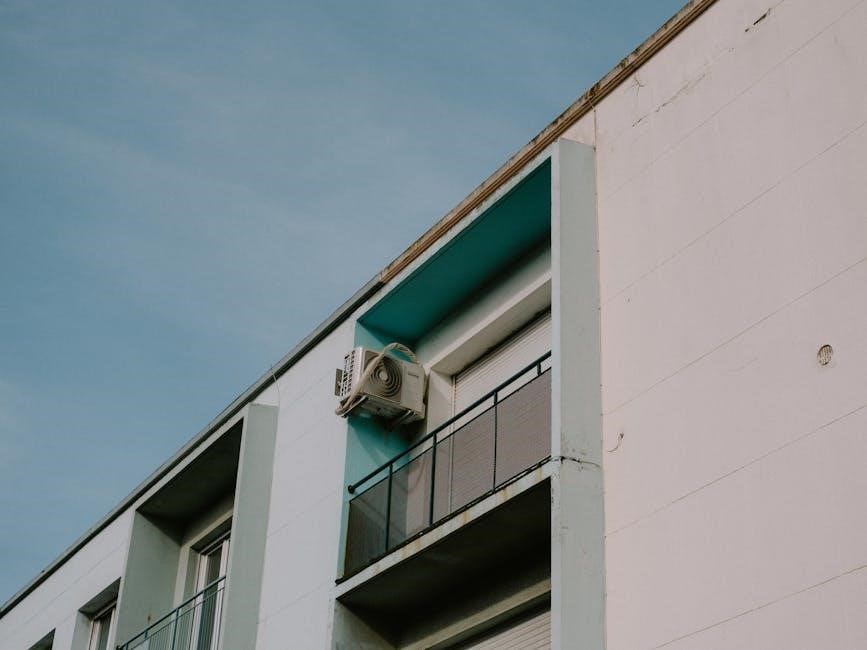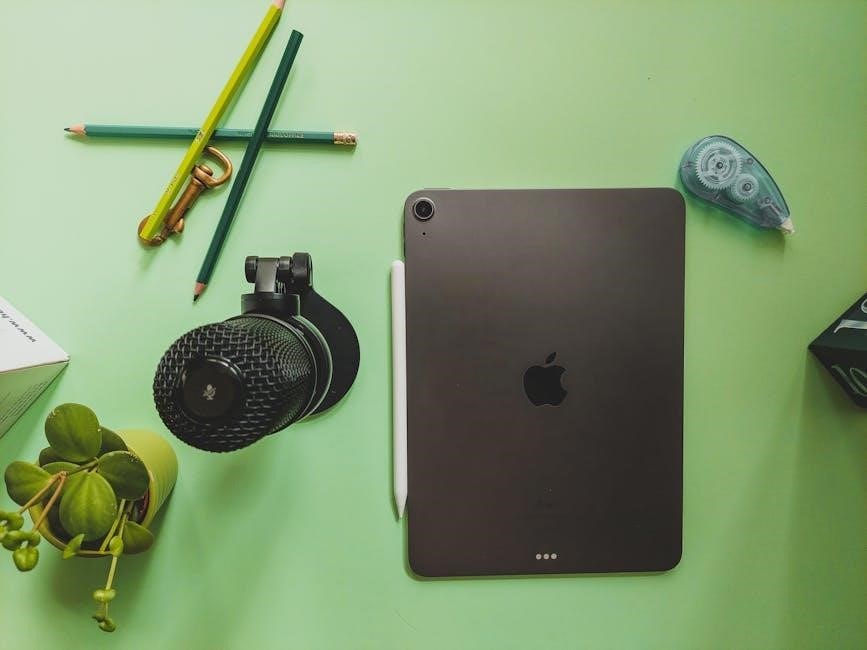Welcome to the Rinnai Portable Air Conditioner Manual. This guide provides essential information for safe and effective operation. Read carefully to understand features‚ safety precautions‚ and proper usage.
1.1 Importance of Reading the Manual
Reading the Rinnai Portable Air Conditioner manual is crucial for safe and efficient operation. It provides essential safety precautions‚ operating instructions‚ and troubleshooting tips. Failure to follow the guidelines can lead to equipment malfunction‚ personal injury‚ or property damage. The manual ensures proper installation‚ maintenance‚ and usage‚ maximizing performance and longevity. Understanding the features‚ modes‚ and error codes helps users address issues promptly. Always comply with the manufacturer’s instructions to avoid risks and ensure optimal functionality. This guide is your key to unlocking the full potential of your Rinnai Portable Air Conditioner while maintaining safety and energy efficiency.
1.2 Overview of the Rinnai Portable Air Conditioner
The Rinnai Portable Air Conditioner is a compact‚ efficient cooling solution designed for versatility and ease of use. It is ideal for rooms of various sizes‚ providing both cooling and heating functions. With a sleek design and advanced features‚ it ensures optimal comfort while being energy-efficient. The unit is lightweight and portable‚ making it easy to move between spaces. It comes equipped with a remote control‚ multiple operating modes‚ and a user-friendly interface. The conditioner also includes features like a timer‚ sleep mode‚ and automatic temperature control. Designed for modern homes‚ it offers reliable performance and adaptability to different environments. Always follow the manual for proper operation.
1.3 Safety Precautions and Warnings
Always prioritize safety when using the Rinnai Portable Air Conditioner. Read the manual thoroughly to avoid equipment malfunction or personal injury. Ensure proper installation in a well-ventilated area‚ away from water sources. Never modify the unit or use damaged power cords. Keep children away from moving parts. Avoid overheating by maintaining a safe distance from flammable materials. Use only genuine Rinnai parts to prevent hazards. Regularly inspect and maintain the unit to ensure safe operation. Failure to follow these precautions may result in serious consequences. Refer to the manual for detailed guidelines to ensure optimal performance and safety.

Key Components of the Rinnai Portable Air Conditioner
The unit features a sleek main design‚ a functional remote control‚ and an efficient air intake grill. These components ensure smooth operation and optimal cooling performance.
2.1 Main Unit and Design Features
The main unit of the Rinnai Portable Air Conditioner is compact and lightweight‚ designed for easy mobility. It features a sleek‚ modern design with a digital display for temperature control. The unit includes a powerful cooling system‚ multiple fan speeds‚ and a heating function for year-round use. Its portable design allows for easy relocation between rooms‚ making it ideal for versatile cooling or heating needs. The main unit also incorporates a user-friendly interface with buttons for mode selection‚ temperature adjustment‚ and timer settings. Key design features include a washable air filter‚ a condensate drain system‚ and a remote control docking station for convenient operation.
2.2 Remote Control and Its Functions
The Rinnai portable air conditioner remote control offers convenient operation. It allows adjustments to temperature settings‚ selection of cooling‚ heating‚ drying‚ and fan modes. Buttons for setting the timer and activating sleep mode enhance energy efficiency. Typically‚ the remote includes buttons for increasing or decreasing temperature‚ adjusting fan speed‚ and switching modes. Some models may have a swing function for air direction control. Always refer to the manual for specific remote functions‚ as they may vary by model; Proper use ensures optimal performance and extends the unit’s lifespan.
2.3 Air Intake Grill and Ventilation System
The air intake grill and ventilation system are critical components of the Rinnai Portable Air Conditioner‚ ensuring proper airflow and efficient cooling. The grill is designed to draw in air‚ which is then cooled and circulated back into the room. Regular cleaning of the grill is essential to maintain performance and prevent dust buildup. The ventilation system‚ including the exhaust hose‚ must be installed correctly to vent hot air outside‚ ensuring optimal operation. Improper installation or blockages can reduce efficiency and potentially damage the unit. Always follow the manual’s guidelines for cleaning and maintaining these parts to ensure reliable functionality and energy efficiency. Proper maintenance enhances both performance and longevity.

Installation and Setup Instructions
Unpack carefully and prepare the unit. Choose a well-ventilated area‚ ensuring it meets room size requirements. Connect the venting system securely and follow manufacturer’s instructions for proper setup.
3.1 Unpacking and Preparing the Unit
Begin by carefully inspecting the package for any signs of damage. Unpack the Rinnai portable air conditioner and ensure all accessories are included. Attach any handles or wheels as instructed. Install the air filters according to the manual’s guidelines. Familiarize yourself with the unit’s components and controls. If a remote control is provided‚ install the batteries and sync it with the unit. Double-check that all parts are properly secured and ready for operation. Finally‚ review the manual to ensure you understand all safety precautions and operational guidelines before turning on the device.
3.2 Choosing the Right Location for Installation
Proper placement of your Rinnai Portable Air Conditioner is crucial for optimal performance. Ensure the unit is installed on a firm‚ level surface in a well-ventilated area. Avoid direct sunlight or heat sources to maintain efficiency. The location should allow easy access to windows for venting and be close to a power outlet.
Keep the unit away from obstructions like furniture or curtains to ensure smooth airflow. Select a location that adheres to the manufacturer’s minimum room size requirements for effective cooling. Proper placement will enhance performance‚ safety‚ and energy efficiency‚ ensuring your space remains comfortable year-round.
3.3 Connecting the Venting System
Proper installation of the venting system is crucial for efficient operation. Attach the vent hose to the air conditioner’s vent outlet‚ ensuring a secure connection. Place the window kit in the desired window‚ adjusting to fit snugly. Seal gaps with the provided foam strip to prevent air leaks. Connect the vent hose to the window kit‚ verifying alignment. Ensure the system is straight and free from bends for optimal airflow. Double-check all connections for tightness to avoid performance issues. Regularly inspect the venting system for damage or blockages. Always follow the manual’s instructions for specific venting configurations. Proper setup ensures safe and efficient cooling performance.

Operating the Rinnai Portable Air Conditioner
Use the control panel or remote to adjust settings. Select modes like Cool‚ Heat‚ or Fan‚ and set desired temperature. Utilize timer and sleep functions for energy efficiency.
4.1 Understanding the Control Panel
The control panel is the central interface for operating your Rinnai Portable Air Conditioner. It features buttons for mode selection (Cool‚ Heat‚ Dry‚ Fan)‚ temperature adjustment‚ and additional functions like Timer and Sleep. The LED display shows the current mode‚ temperature setting‚ and any active features. Familiarize yourself with each button’s function to optimize performance. The control panel also includes indicators for error codes or maintenance reminders. Always refer to the manual for detailed explanations of symbols and buttons to ensure proper operation. Understanding the control panel is key to maximizing efficiency and comfort while using your air conditioner.

4.2 Setting the Temperature and Modes
The Rinnai Portable Air Conditioner allows precise temperature control‚ ranging from 62°F to 86°F. Use the control panel or remote to adjust settings. Select modes like Cool‚ Heat‚ Dry‚ or Fan to suit your needs. The unit also features a 24-hour timer and sleep mode for energy efficiency. Ensure the temperature is set correctly for optimal performance and energy savings. Always refer to the manual for specific mode instructions and to understand the unit’s capabilities fully.
4.3 Using the Timer and Sleep Functions
The Rinnai Portable Air Conditioner features a convenient timer and sleep function for enhanced user comfort and energy efficiency. The timer allows you to set specific operation times‚ ensuring the unit turns on or off automatically. This is ideal for maintaining a comfortable environment without constant manual adjustments. The sleep function adjusts the temperature gradually‚ preventing extreme heat or cold during the night. Both functions can be easily controlled via the remote control. Use the timer to schedule cooling or heating sessions in advance‚ and activate the sleep mode for uninterrupted rest. These features not only improve convenience but also help reduce energy consumption.

Maintenance and Cleaning Guidelines
Regular maintenance ensures optimal performance. Clean air filters monthly‚ drain condensed water‚ and inspect hoses. Check condenser coils for dust and ensure proper ventilation for efficiency.
5.1 Cleaning the Air Filters

Regular cleaning of the air filters is crucial for maintaining the efficiency and performance of your Rinnai Portable Air Conditioner. To clean the filters‚ turn off the unit and unplug it for safety. Remove the filters according to the manufacturer’s instructions‚ typically located at the back or bottom of the unit. Gently wash the filters with warm water or a soft brush to remove dust and debris. Allow them to dry completely before reinstalling. This process ensures optimal airflow and prevents potential malfunctions. Cleaning the filters every 1-2 weeks is recommended‚ depending on usage and environmental conditions. Always refer to the manual for specific guidance.
5.2 Draining Condensed Water
Regularly draining condensed water is crucial for maintaining your Rinnai Portable Air Conditioner’s efficiency and preventing leaks. Locate the water tank‚ usually at the rear or bottom of the unit. When full‚ turn off the device and empty the tank. For continuous drainage‚ attach the provided drainage hose to the unit and direct it to a suitable location. Ensure the hose is securely connected to avoid water spillage. Clean the tank periodically to prevent mold buildup. Refer to the manual for specific drainage instructions tailored to your model. Proper drainage ensures optimal performance and extends the lifespan of your air conditioner.
5.3 Regular Maintenance Tips
Regular maintenance ensures optimal performance and extends the lifespan of your Rinnai Portable Air Conditioner. Clean the air filters every two weeks to prevent dust buildup. Check the drain pan regularly and ensure proper water drainage to avoid leaks. Inspect the venting system for blockages or kinks‚ as this can reduce efficiency. Wipe down the exterior and interior surfaces with a soft cloth to maintain hygiene. Additionally‚ ensure the unit is placed on a level surface to prevent uneven cooling. Schedule professional maintenance annually to inspect internal components and refrigerant levels. By following these tips‚ you can ensure your air conditioner runs efficiently and reliably year-round.

Troubleshooting Common Issues
This section helps diagnose and resolve common problems‚ such as error codes‚ cooling inefficiency‚ or unusual noises‚ ensuring optimal performance of your Rinnai Portable Air Conditioner.
6.1 Common Error Codes and Solutions
Your Rinnai Portable Air Conditioner may display error codes like E1‚ E2‚ or E3. These indicate issues such as sensor malfunctions or refrigerant leaks. Always refer to the manual for specific code meanings. For example‚ E1 often relates to temperature sensor problems‚ while E2 may signal a drainage issue. Solutions include resetting the unit‚ checking sensors‚ or ensuring proper drainage. If issues persist‚ contact Rinnai support for professional assistance. Regular maintenance‚ like cleaning filters‚ can prevent many errors. Always follow the manual’s troubleshooting guide before attempting repairs. This ensures safety and optimal performance of your air conditioner.
6.2 Resolving Cooling or Heating Issues
If your Rinnai portable air conditioner is not cooling or heating properly‚ check for common issues. Ensure the air filters are clean and free from blockages. Verify that the thermostat is set correctly and the remote control functions are working. Inspect the venting system for kinks or obstructions‚ as proper airflow is crucial. If the unit is not sized appropriately for the room‚ it may struggle to maintain the desired temperature. Drainage issues can also affect performance‚ so ensure the water tank is empty and the drainage system is functioning. Consult the manual for specific troubleshooting steps or contact Rinnai support for assistance.
6.3 Addressing Noise or Leaking Problems
If your Rinnai portable air conditioner is making unusual noises or leaking water‚ address these issues promptly. Noise may result from loose parts or improper installation. Check for blockages in the venting system and ensure the unit is placed on a level surface. For leaks‚ inspect the drain hose for kinks or damage. Clean the condensate tank regularly and ensure proper drainage. If issues persist‚ refer to the troubleshooting section or contact Rinnai customer support for assistance. Regular maintenance can prevent such problems and ensure optimal performance.

Eco-Friendly and Energy-Efficient Features
The Rinnai Portable Air Conditioner incorporates energy-saving modes and eco-friendly refrigerants‚ ensuring efficient cooling while reducing environmental impact and lowering energy consumption.
7.1 Energy-Saving Modes and Settings
The Rinnai Portable Air Conditioner features energy-saving modes designed to reduce power consumption while maintaining comfort. The Eco Mode adjusts operation to optimize energy efficiency‚ lowering costs and environmental impact. Additionally‚ a built-in timer allows scheduling cooling sessions‚ preventing unnecessary energy use. Sleep Mode further enhances efficiency by gradually adjusting temperature settings during sleep hours. These settings ensure the unit operates efficiently without compromising performance. By utilizing these modes‚ users can enjoy cost-effective and eco-friendly cooling solutions. Proper use of these features not only saves energy but also extends the unit’s lifespan‚ aligning with Rinnai’s commitment to sustainability and user convenience.
7.2 Eco-Friendly Refrigerant Information
The Rinnai Portable Air Conditioner uses eco-friendly refrigerants‚ such as R-32‚ which have lower global warming potential compared to older refrigerants. These refrigerants are designed to minimize environmental impact while maintaining high energy efficiency. The unit adheres to international regulations and standards for reducing ozone-depleting substances. By utilizing advanced refrigeration technology‚ Rinnai ensures that its portable air conditioners contribute to a greener future. Proper handling and disposal of refrigerants are emphasized in the manual to prevent environmental harm. This commitment to sustainability makes the Rinnai Portable Air Conditioner an environmentally responsible choice for cooling needs.

Additional Resources and Support
For further assistance‚ contact Rinnai customer service or visit their official website for detailed manuals‚ guides‚ and troubleshooting tips. Additional support resources are available online.
8.1 Contacting Rinnai Customer Service
For any inquiries or assistance with your Rinnai Portable Air Conditioner‚ contact Rinnai Customer Service. You can reach them via phone‚ email‚ or through the official website. Visit the Rinnai website for contact details and additional resources. The website also provides access to manuals‚ FAQs‚ and troubleshooting guides. Ensure to have your model number ready for faster assistance. Customer support is available during business hours‚ Monday to Friday. For urgent issues‚ consider using the live chat feature or calling directly. Always refer to the manual for specific contact information and support options tailored to your region.
8.2 Accessing Online Manuals and Guides
For convenient access‚ Rinnai provides digital versions of the portable air conditioner manual on their official website. Visit the Rinnai website‚ navigate to the “Support” section‚ and search for your specific model. Download the PDF manual for easy reference. Additionally‚ registering your product online ensures access to exclusive resources‚ including troubleshooting guides and video tutorials. Online manuals are updated regularly‚ offering the latest information and maintenance tips. Utilize these resources to optimize your unit’s performance and address any operational queries efficiently.
9.1 Summary of Key Points
The Rinnai Portable Air Conditioner Manual is a comprehensive guide designed to ensure safe and efficient operation. Key points include proper installation‚ regular maintenance‚ and understanding energy-efficient features. Always read the manual thoroughly before use to avoid malfunctions and ensure optimal performance. Cleaning air filters and draining condensed water are crucial for longevity. Familiarize yourself with the control panel and remote functions for seamless operation. Troubleshooting common issues‚ like error codes or noise problems‚ is simplified with the provided solutions. Eco-friendly modes and refrigerant information highlight Rinnai’s commitment to sustainability. By following these guidelines‚ you can maximize comfort while minimizing energy consumption and environmental impact.
9.2 Final Tips for Optimal Performance
To ensure your Rinnai Portable Air Conditioner runs efficiently‚ maintain regular cleaning of filters and vents. Proper placement in a well-ventilated area maximizes cooling performance. Use the timer and eco-mode for energy savings. Check for blockages in the venting system and keep the remote control batteries charged. Avoid overloading the unit with excessive cooling demands. For optimal results‚ follow the recommended room size guidelines. Always refer to the manual for specific maintenance and operation tips. By adhering to these practices‚ you’ll enjoy consistent comfort and extend the lifespan of your air conditioner. Remember‚ proper care ensures reliable performance and energy efficiency.
